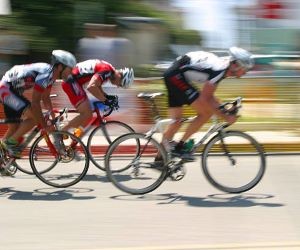Master endurance cycling in tropical climates with effective strategies. Learn hydration, heat adaptation, and training tips for peak performance.
HOW DO I TRAIN FOR EXPLOSIVE ACCELERATIONS?
Explosive accelerations are critical for athletes across cycling, running, and team sports. Effective training focuses on neuromuscular power, strength, technique, and recovery. By combining resistance training, plyometrics, interval work, and skill-specific drills, athletes can improve sprint capacity, reaction time, and overall explosive performance. Understanding the science behind acceleration allows for structured progression and reduces injury risk, enabling athletes to dominate short, high-intensity efforts.

Understanding explosive acceleration
Explosive acceleration is the ability to generate maximal force in a short period, allowing rapid increases in speed. It combines neuromuscular efficiency, muscle fiber recruitment, and biomechanical optimization. Athletes must engage fast-twitch fibers effectively to translate strength into rapid motion.
Physiological factors
Fast-twitch muscle fibers (Type IIa and IIx) are the primary drivers of explosive movements. Strength, rate of force development, and coordination between agonist and antagonist muscles determine acceleration potential. Additionally, tendon stiffness and joint mechanics influence power transfer.
Type II muscle fiber recruitment for high power output
Neuromuscular coordination to synchronize muscle firing
Optimal joint angles for efficient force transfer
Tendon stiffness supporting elastic energy storage and release
Biomechanical considerations
Efficient technique ensures maximal acceleration with minimal energy wastage. Proper posture, stride length, limb angle, and foot placement are crucial. In cycling, pedaling technique, crank mechanics, and body position influence force application during sprints or accelerations.
Maintain low, forward-leaning posture to optimize power output
Maximize pedal stroke or stride efficiency
Minimize unnecessary lateral or vertical movement
Engage core and stabilizers to transfer force effectively
Strength training for acceleration
Building maximal strength in key muscle groups is foundational for explosive accelerations. Targeting lower body, core, and hip muscles increases force output and supports neuromuscular efficiency during rapid movements.
Lower body exercises
Squats, deadlifts, lunges, and step-ups develop quadriceps, hamstrings, glutes, and calves. Emphasizing heavy loads with low-to-moderate repetitions enhances maximal strength, which can later be converted into explosive power.
Back and front squats for quadriceps and glutes
Romanian deadlifts for hamstrings and posterior chain
Weighted lunges for unilateral stability
Calf raises for ankle power and push-off strength
Core and stabilizer work
A strong core facilitates effective force transfer and balance. Planks, rotational exercises, and anti-rotation movements strengthen stabilizers, allowing athletes to generate and control explosive movements efficiently.
Planks and side planks for core stability
Medicine ball rotational throws for rotational power
Anti-rotation cable exercises for control
Plyometrics and explosive drills
Plyometric exercises train muscles and tendons to store and release elastic energy rapidly. Jumping, bounding, and sprint drills develop rate of force development and enhance fast-twitch fiber activation for rapid acceleration.
Jump and bounding exercises
Box jumps, depth jumps, and single-leg hops target lower body power. Controlled landing mechanics reduce injury risk while maximizing explosive output.
Box jumps for vertical power and hip extension
Depth jumps to enhance stretch-shortening cycle efficiency
Single-leg hops for unilateral strength and balance
Bounding drills to improve stride length and reactive strength
Sprint-specific drills
Short-distance sprints, resisted sprints, and flying sprints improve acceleration mechanics, stride frequency, and neuromuscular coordination.
10–30 meter sprints for maximum acceleration focus
Resisted sprints with sleds or bands for power overload
Flying sprints for top-speed maintenance and transition work
Acceleration from different starting positions for neuromuscular adaptation
YOU MAY ALSO BE INTERESTED






